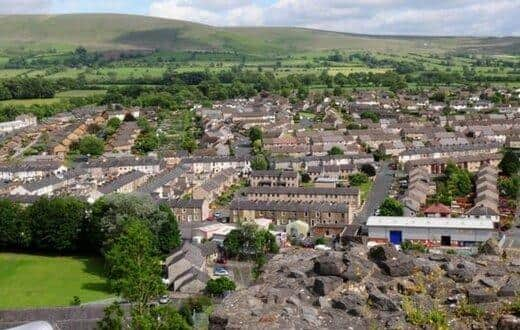Boundary review: plans announced to make Clitheroe part of new Pendle constituency
and live on Freeview channel 276
A new Pendle and Clitheroe seat – also including Whalley – would be created under the final version of proposals put forward by the Boundary Commission for England.
The organisation has been carrying out a review of the current arrangements, but has now made what it describes as “comprehensive” changes to its initial suggestions for the county in the wake of the objections that several of them attracted.
Advertisement
Hide AdAdvertisement
Hide AdThe commission says that as a result of its revised plans for other constituencies, some part of Ribble Valley has to be included in a seat with another local authority area – notwithstanding the fact that Clitheroe is home to the headquarters of Ribble Valley Borough Council. The town’s place within the district authority would not be affected by the proposals.


However, sitting Ribble Valley MP Nigel Evans – who has represented the patch for 30 years – told the Clitheroe Advertiser that he was “deeply saddened by any split up of my local authority area [from] being coterminous with my constituency”, adding that he hoped the commission would take on board that concern.
Commissioners say they have opted to marry up Clitheroe with Pendle because of their similar rural character, which make it a more suitable match for the town than either Hyndburn or Burnley. They also suggests that the new seat would contain “a large enough Ribble Valley element that there would be no question of the area being ‘overlooked’”.
Residents, MPs and political parties were first asked for their views on initial proposals during the summer of 2021 and then got a second opportunity to have their say earlier this year, including at 32 public hearings held across the country - one of which was staged in Preston.
Advertisement
Hide AdAdvertisement
Hide AdA final period of public consultation has now begun over the latest plans, which attempt to address some of the concerns raised by Lancastrians, while still fulfilling the commission’s remit to ensure a more equal number of potential voters in each constituency.


The potential impact on Clitheroe is a demonstration of the knock-on nature of boundary change proposals - and the divergent reactions that they can prompt in a county as diverse as Lancashire, where local identities are often staunchly defended.
The commission says that its plans for a Pendle and Clitheroe constituency do serve to address disquiet surrounding what it had initially proposed for the Ribble Valley. That would have seen the Billington & Langho, East Whalley Read & Simonstone and Whalley & Painter Wood wards placed within the Hyndburn constituency.
However, the commission revealed that it received a large number of objections “contending that there are no community ties between these areas and Accrington”.
Advertisement
Hide AdAdvertisement
Hide AdRespondents also stressed that Whalley is “intrinsically linked more to Clitheroe and the wider Ribble Valley than to Accrington or other parts of Hyndburn” - and objected that original proposals would have divided the town by retaining the Whalley Nethertown ward alone in the Ribble Valley constituency.
Assistant commissioners visited the area and concluded that the Whalley and Clitheroe areas were “similar in nature”, with a shared rural character and particularly good transport and communication links.
For that reason - and to accommodate the configurations proposed elsewhere - they suggested creating a new consistency of Pendle and Clitheroe. That would contain ten wards from the Ribble Valley borough incorporating Clitheroe and Whalley - and all of the Pendle district except the two Brierfield wards, which move to the Burnley constituency.
The commission said: “We acknowledge that it could be considered that the constituencies might not best reflect local ties, in particular not including Clitheroe in a constituency with the remainder of the Ribble Valley. However, we believe that our proposals here go some way to addressing concerns expressed in representations from both Hyndburn and Whalley that the two areas have little to nothing in common.
Advertisement
Hide AdAdvertisement
Hide Ad“We also consider that the beneficial consequences of proposing these constituencies – namely, the retention of five existing constituencies that are wholly unchanged, or changed only to realign with local government ward boundary changes – is, on balance, a superior and more appropriate pattern of constituencies than were the initial proposals, particularly in view of the very considerable opposition that the latter generated in those parts of Lancashire.”
HAVE YOUR SAY
The public consultation on the commission's latest proposals runs until 5th December. Comments relating to the Lancashire area can be made online at bcereviews.org.uk/node/6487, where constituency maps are also available to assist residents in giving feedback.
Tim Bowden, Secretary to the Boundary Commission for England, said:
“Last year we published our initial proposals for new constituency boundaries - our first go at what the map should look like.
Advertisement
Hide AdAdvertisement
Hide Ad“We are delighted with the huge number of comments from members of the public on our initial proposals, many which included valuable evidence about local communities.
“Today’s publication is the culmination of months of analysis and we have revised nearly half of our initial proposals based on what people have told us. We now believe we are close to the best map of constituencies that can be achieved under the rules we are working to.
“However, we still want people to tell us what they think of this latest map before we submit our final recommendations to Parliament next year. This is our final consultation and I encourage you to participate in the 2023 Boundary Review.”
WHAT HAPPENS NEXT?
After the consultation closes, the Boundary Commission for England will draw up its final recommendations, which must be presented to the Speaker of the House of Commons by 1st July next year.
Advertisement
Hide AdAdvertisement
Hide AdWithin four months of the last report being laid by the boundary commissions for each of the four nations, the government is required to submit to the Privy Council an order that gives effect to all of their recommendations.
No further changes can be made, unless specifically requested by the relevant commission - and any such request would itself have to be laid before Parliament and published.
The new constituencies take effect at the next General Election after the Privy Council approves the order. Any by-elections held in the meantime have to be conducted on the basis of the existing constituency boundaries.